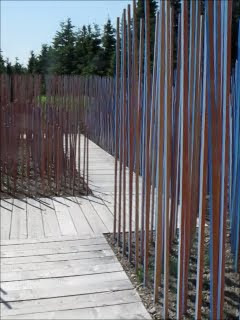Merry and I love visiting gardens. Our long-standing desire to visit the historic Reford Gardens was part of the reason we decided to vacation in Gaspésie this year. We learned of this garden some years ago on our first visit to Frank Cabot's amazing garden, Les Quatre Vents, on the north shore of the St. Lawrence. You can get an idea of just how wonderful Cabot's private garden is at: http://www.northerngardening.com/public_gardens/les_quatre_vents.htm Les Quatre Vents is far and away the most beautiful and most interesting garden I have ever visited. When we found there was also an important garden on the south shore, we wanted to visit, but since it is much further down the river we had to save it for a separate trip. It took us almost ten years to return.
Day 7 - To Métis-sur-Mer
After hiking in the morning and a nice seafood (what else?) lunch we finally headed west on Route 132. I had settled on Métis-sur-Mer as a promising destination. In the nineteenth century this village was a favorite vacation spot for Scottish families from Montreal. The village is still composed of mostly English-style cottages with high privacy hedges. The village spreads along a large bay on the River with a picturesque lighthouse at the western end. We looked at an inn in the village center, but decided instead to stay in a very private small cottage right on the river at Auberge Métis-sur-mer www.aubergemetissurmer.qc.ca/bienvenue_en.htm. From our porch we could see some small rocky islands and the lighthouse. Seals occupied the rocks further out. We were the only diners at the superb restaurant maintained by the Auberge: poached salmon with baby shrimp. The meal was perhaps the best we've had on this trip of very good fish dinners. We fell blissfully asleep despite the bright green light that flashed across the bedroom, three flashes in an row, six times a minute, warning sailors along this rocky coast.
Day 8 - Reford Gardens at Grand Métis
After a nice breakfast at the Auberge, we drove about 5 minutes west to Reford Gardens http://www.jardinsdemetis.com/english/. A giant Adirondack-style chair marks the entrance. This is largely a woodland garden built along the banks of a stream. Because of the compressed late spring this far north almost every conceivable spring flower was in full bloom when we visited. There is an impressive azalea garden. I was also impressed by the gentian garden as well as a nice collection of primulas in full bloom. Of course, we saw the famous Himalayan blue poppy that is the garden's trademark. At the heart of the garden, on a lawn with a belvedere overlooking the River, is the summer home of Elsie Reford, the original designer of the gardens. An extensive exhibit in the house shows how 19th century robber baron wealth was used to transform this place into a pleasure ground for wealthy Anglophones from Montreal.
The garden is now a non-profit directed by Elsie Reford's grandson, Alexander. In recent years the garden has hosted an international garden design festival that, unfortunately, was not yet open when we visited. One piece from an earlier festival was set up on the main lawn. It consists of a dense group of blue stakes of various heights painted different shades of blue and orange on each side and set up to walk through. The effect is hypnotic and fun. I had to laugh as I heard some folks from a bus tour walk up and remark, “It's just sticks.” One serious fellow heard me laughing and noted, “some people are easily amused.” We wandered through a collection of other more traditional contemporary sculpture. We both agreed sculptures made of rounded boulders tightly contained in rusted steel by Jean Brillant were especially wonderful. Finally, we relaxed with some nice salads in the garden gazebo (green beans and onion for me, smoked mackerel and potato for Mer).
We both liked this garden. It has charm, is nicely laid out and very well maintained, yet we agreed that it does not qualify as one of the great gardens of the world. It aspires to this greatness, and may someday achieve it. It was a very pleasant way to spend part of our day.
Back at the Auberge I indulged myself with an hour massage by Lise, then a light supper of fresh baked bread, salad and a savory mushroom soup. We watched the tide come in one last time.
Day 9/10 – Home again
We reluctantly leave the Auberge after breakfast. We need to make miles today. We hope to get at least to Montreal by nightfall. We stop briefly near the village of St. Denis to look at the long dike built to recover marshy fields. On to the small town of La Pocatiere where we have a very nice lunch at Cafe Azimut. Merry visited her sister, Nora, in small this town with a major agricultural college back in 1971 while Nora was attending French language Peace Corps training before being posted to Africa. We get back on the highway and after some hairy driving in a thunderstorm we pull into the Comfort Inn at Boucherville, a suburb of Montreal, about 4:30. We're up early the next day and make it to the bridge at Ogdensburg before lunch. Because of our long trip through Quebec we expect problems at customs, but this doesn't happen. When I say we are bringing back some smoked salmon, the customs agent helpfully does the math to show we have well less than the 50 pounds allowed. We pass the time traveling south on I-81 trying to imagine a utopian novel that would include all our progressive values. Home at last, we meet our dog sitter, Mary, as she is just finishing her last visit. Joli is happy to see us. Ah!









